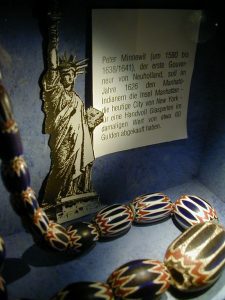Chevron beads - German/German

For the Indians of North America, glass was an unknown material. Glass beads therefore had a high commercial value for them. The first European glass beads are said to have arrived in the New World with Christopher Columbus in 1492. They were first offered as gifts to the Indians by explorers and missionaries. Later they played an important role as barter goods, among other things in the fur, tobacco and slave trades. Glass beads were used profitably by Europeans in the struggle to conquer and exploit the new colonies.
Peter Minnewit was the first governor of New Holland. In 1626, he is said to have bought Manhattan Island - now the City of New York - from the Manhato Indians for a handful of glass beads. At the time, this was worth about 60 guilders, which was the approximate annual salary of a master mason or the value of 10 horses or 50 cattle! Spaniards, French and English mainly used Venetian glass beads for barter. The Dutch, on the other hand, traded mainly with their own beads in the period from 1600 to about 1750.
The Venetian-style glass beads made in Amsterdam included chevron beads like these. Thea Elisabeth Haevernick examined the chevron beads and found that they did not originate in Egypt, but were made in Venice in the 15th century at the earliest. Only later are they said to have been made by emigrated Venetians also in Amsterdam and in the Thuringian Forest. By the way, "chevron" means "zigzag".
Chevron Beads - English

To the North American Indians glass was an unknown material and glass beads therefore carried a high trade value. The first European glass beads are supposed to have been introduced to the new world by Christopher Columbus and his crew in 1492. Researchers and missionaries first offered them to the Indians as gifts. But they later played an important role as bartered goods for among others, fur, tobacco and slaves. The Europeans used glass pearls to their advantage in the battle for the conquest and exploitation of the new colonies.
Peter Minnewit was the first governor of New Holland. In 1626 he's supposed to have bought the island of Manhattan - today's New York City - from the Manhato Indians for a handful of glass beads. At the time they were valued at around 60 guilders, which was a master bricklayer's yearly wage, or the value of 10 horses or 50 cows. The Spanish, English and French mainly used Venetian glass beads for the barter trade, while the Dutch traded their own beads from 1600 to around 1750.
Chevron beads were some of those made in Amsterdam in Venetian style. Thea Elisabeth Haevernick had the chevron beads examined and concluded that they didn't come from Egypt, but from 15th century Venice. It was only later that day were produced in Amsterdam and the Thuringian Forest by Venetian immigrants. Chevron means zigzag by the way.